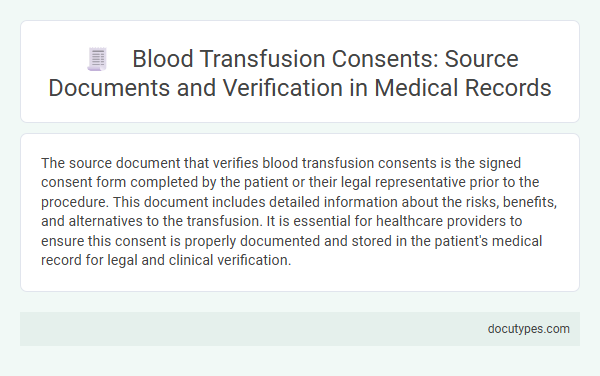The source document that verifies blood transfusion consents is the signed consent form completed by the patient or their legal representative prior to the procedure. This document includes detailed information about the risks, benefits, and alternatives to the transfusion. It is essential for healthcare providers to ensure this consent is properly documented and stored in the patient's medical record for legal and clinical verification.
Introduction to Blood Transfusion Consents
Blood transfusion consents are critical documents that ensure patients understand the risks and benefits associated with receiving blood products. These consents protect both the patient and healthcare provider by verifying informed agreement before the procedure.
The source document that verifies blood transfusion consents is typically a signed consent form kept in the patient's medical record. Your healthcare provider must obtain and document this consent to comply with legal and medical standards in blood transfusion practices.
Legal and Ethical Foundations of Consent
| Aspect | Description |
|---|---|
| Source Document | Blood transfusion consent form, signed by the patient or authorized representative before the procedure |
| Legal Foundation | Informed consent laws require documentation of voluntary and informed agreement to blood transfusion, protecting patient autonomy and rights |
| Ethical Foundation | Respect for patient autonomy and beneficence demand clear communication and valid consent prior to transfusions, ensuring ethical medical practice |
| Verification Process | Healthcare providers must confirm the signed consent document matches the patient identity and transfusion procedure to maintain compliance |
| Your Role | You should ensure your consent form is properly completed and understood before undergoing blood transfusion to protect your legal rights and health |
| Documentation Storage | Consent forms are stored in the patient's medical record as legal proof of authorization and for future clinical reference |
Key Elements of Blood Transfusion Consent Forms
The primary source document that verifies blood transfusion consents is the signed consent form. This document ensures that Your permission was informed and clearly documented before the procedure.
- Patient Identification - Includes full name, date of birth, and medical record number to confirm the patient's identity.
- Procedure Description - Specifies the type and purpose of the blood transfusion being authorized.
- Risks and Benefits Disclosure - Details potential complications and the expected benefits to inform the patient's decision.
Procedures for Obtaining Informed Consent
The source document that verifies blood transfusion consents is the signed informed consent form completed by the patient or their legal representative. Procedures for obtaining informed consent require healthcare providers to explain the benefits, risks, and alternatives of the transfusion in a clear and comprehensible manner. Proper documentation of the consent process ensures legal compliance and safeguards patient autonomy during blood transfusion.
Documentation Standards for Source Documents
Source documents that verify blood transfusion consents are critical for patient safety and legal compliance. Proper documentation standards ensure the consent is valid, clearly recorded, and accessible for medical staff review.
- Consent Form - The primary source document that records the patient's or authorized representative's agreement for blood transfusion.
- Medical Record - Includes detailed notes from healthcare providers confirming that informed consent has been obtained prior to the transfusion.
- Electronic Health Record (EHR) - Digitally stores signed consent forms and timestamps, providing secure and verifiable documentation of consent.
Your adherence to standardized documentation procedures helps maintain clear communication and legal protection during blood transfusions.
Verification Protocols in Medical Records
The source document that verifies blood transfusion consents is the signed consent form included in the patient's medical records. Verification protocols require healthcare providers to confirm the presence and accuracy of this document before proceeding with the transfusion. Proper documentation ensures legal compliance and patient safety by recording informed consent explicitly related to blood transfusion procedures.
Common Challenges in Consent Verification
What source document verifies blood transfusion consents? The primary document verifying blood transfusion consents is the signed consent form completed by the patient or authorized representative. This form ensures legal authorization and patient awareness of the procedure risks and benefits.
What are common challenges in consent verification for blood transfusion? Challenges include incomplete or missing consent forms, ambiguous patient identification, and time-sensitive situations requiring rapid verification. These obstacles can lead to delays, errors, and potential legal complications in transfusion protocols.
Technology and Digital Consent Management
Source documents verifying blood transfusion consents have evolved significantly with advances in technology and digital consent management systems. These documents are typically stored within electronic health records (EHR), ensuring accurate and accessible verification.
Digital consent platforms provide secure, timestamped records that improve compliance and patient safety during blood transfusions. Your healthcare provider can efficiently retrieve and confirm consent details using integrated hospital information systems.
Audit and Compliance in Blood Transfusion Documentation
Source documents verifying blood transfusion consents are essential for maintaining audit and compliance standards in medical records. Proper documentation ensures legal protection and patient safety during blood transfusion procedures.
- Consent Form - The primary source document signed by the patient or legal guardian confirming informed consent for transfusion.
- Medical Record Entry - A detailed note by the healthcare provider documenting the consent process and discussion of transfusion risks and benefits.
- Audit Trail Report - An electronic or manual record showing timestamped consent verification to support regulatory compliance during audits.
What Source Document Verifies Blood Transfusion Consents? Infographic

